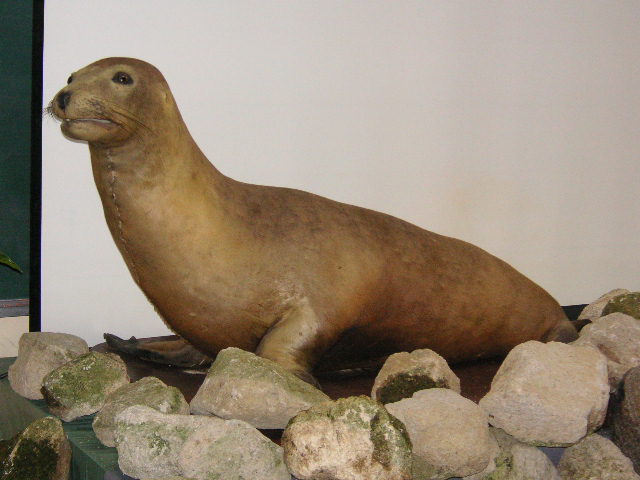Japanese Sea Lion
From Wikipedia, the free encyclopedia
Order: Carnivora
Family: Otariidae
Subfamily: Otariinae
Status: Extinct (1950s)
[Photo] Japanese Sea Lion (Zalophus japonicus). 天王寺動物園に保存されているニホンアシカの???製(大阪市立天王寺動物園にて:2006年11月4日、本人撮影). Date 4-11-2006. Author http://ja.wikipedia.org/wiki/Nkensei | Permission is granted to copy, distribute and/or modify this document under the terms of the GNU Free Documentation License, Version 1.2 or any later version published by the Free Software Foundation; with no Invariant Sections, no Front-Cover Texts, and no Back-Cover Texts. A copy of the license is included in the section entitled "GNU Free Documentation License". |
The Japanese Sea Lion (Zalophus japonicus or Zalophus californianus japonicus) is thought to have become extinct in the 1950s.
Prior to 2003 it was considered to be a subspieces of California Sea Lion (Zalophus californianus ssp. japonicus); however, it was subsequently reclassified as a separate species. But many taxonomists still consider it as a subspecies of the California Sea Lion. Some have argued that japonicus, californianus, and wollenbaeki (Gal??pagos Sea Lion) are distinct species because of their distant habitation areas and behavioral differences.
They inhabited the East Sea, especially around the coastal areas of the Japanese Archipelago and the Korean Peninsula. They generally bred on sandy beaches which were open and flat, but sometimes in rocky areas.
Currently, several stuffed specimens can be found in Japan and the National Museum of Natural History, Leiden, the Netherlands brought by Philipp Franz von Siebold. The British Museum is holding a pelt and 4 skull specimens.
Physical description
Male Japanese Sea Lions were dark gray and weighed up to 450 to 560 kg reaching lengths of 2.3 to 2.5 meters; these were larger than male California Sea Lions. Females were significantly smaller at 1.64 meters long with a lighter color than the males.
Range and habitat
Japanese Sea Lions were primarily found in the Sea of Japan along the coastal areas of the Korean Peninsula, the mainlands of the Japanese Archipelago (the both sides on the Pacific Ocean and Sea of Japan), the Kuril islands, and southern tip of the Kamchatka Peninsula.
Old Korean accounts also describe that the sea lion and Spotted Seal (Phoca largha) were found in broad area containing the Bo Hai, the Yellow Sea, and Sea of Japan. The sea lions and seals left a lot of relevant place names all over the coast line of Japan such as Ashika-iwa (アシカ岩, sea lion rock) and Inubosaki point (犬吠崎, lit. dog-barking point) because of the similarity of their howls.
Lifestyle and reproduction
They usually bred on flat, open and sandy beaches but rarely in rocky areas. Their preference was to rest in caves.
Human uses
Many bones of Japanese Sea Lion have been excavated from shell middens in J??mon period in Japan while an 18th century's encyclopedia, Wakan Sansai Zue describes that the meat was not tasty and they were only used to render oil for oil lamps. Valuable oil was extracted from the skin, its internal organs were used to make expensive oriental medicine, and its whiskers and leathers were used as pipe cleaners and leather goods, respectively. Later, they were captured for use in circuses.
Japanese Fishery
In 1903, Nakai Y??zabur??, a Japanese businessman, built a fishery house on the uninhabited Liancourt Rocks to aid in harvesting them and subsequently, until the outbreak of World War II in 1941, the hunting of sea lions in this location was subject to government approval. A former fisherman of the Oki Islands stated that they worked to protect the sea lion population to ensure perpetuity of the resource before WWII.
Extinction
Harvest records from Japanese commercial fishermen in the early 1900s show that as many as 3,200 sea lions were harvested at the turn of the century and overfishing caused harvest numbers to fall drastically to 300 sea lions by 1915 and to few dozen sea lions by the 1930s. Commercial harvest of Japanese sea lions ended in the 1940s when the species became virtually extinct. In total, Japanese trawlers harvested as many as 16,500 sea lions, enough to cause their extinction. The last colony of sea lions was allegedly sighted by Korean coast guards in the 1950s and the last confirmed record of a Zalophus japonicus in Japan was a juvenile, captured in 1974 off the coast of Rebun Island, northern Hokkaido. Other unconfirmed sightings exist but it is possible these were, however, escaped Zalophus californianus seals.
Population Revival Efforts
The South Korean Ministry of Environment initiated an effort to search for and reintroduce sea lions to their native habitat. The National Institute of Environmental Research of Korea was commissioned to conduct feasibility research for this project. In 2007 a joint research venture between North Korea, South Korea, Russia, and China was announced. Surviving California sea lion populations will be searched in Chinese and Russian waters with hopes reintroducing the stock to not only the Liancourt Rocks, but all over the coast of Sea of Japan. If they can not find them, the South Korean government plans to bring some from the United States. The South Korean Ministry of Environment said that it is meaningful in the senses of the territorial symbolism, the national concern, the restoration of ecologic systems, and possible eco tourisms, to restore the sea lions on the Liancourt Rocks that became extinct by Japanese overhunting.
http://en.wikipedia.org/wiki/Japanese_Sea_Lion
| The text in this page is based on the copyrighted Wikipedia article shown in above URL. It is used under the GNU Free Documentation License. You may redistribute it, verbatim or modified, providing that you comply with the terms of the GFDL. |
|

